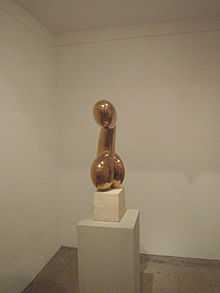Princess X

"Princess X" is a sculptured rendering of the French princess, Marie Bonaparte, by the artist Constantin Brâncuși. Princess Bonaparte was the great-grand niece of the emperor Napoleon Bonaparte. The artist, Constantin Brâncuși, was born in Hobijta, Romania in early 1876. The piece was created between 1915 and 1916. The sculpture was originally the final piece of a collection of sketches, Brâncuși worked on. The polished bronze atop a limestone block stands a little over two and a half feet tall, and is currently being held at the Philadelphia Museum of Art.[1]
Brâncuși was born in a small Romanian village in 1876. At eleven years old, Brâncuși left his village and traveled through several Romanian cities, where he worked in several different crafts. He set foot in Paris in 1904, where he began sculpting and perfecting his style, later recognized as simplistic and abstract.[2]
According to the Philadelphia Museum of Art, Brâncuși had been "at the center of two of modern arts most notorious scandals." One of the scandals being that the Salon des Indépendants, in Paris where Brâncuși practiced his trade, discontinued the display of Princess X from its establishment for its apparent obscene content, as some thought it looked like a penis.[3] After having his art taken off display, Brâncuși was shocked. He declared the incident a misunderstanding. He had created Princess X not as a sculpture depicting a more masculine subject, but the object of feminine desire and vanity.
After much accusation, Brâncuși insisted the sculpture had been his rendition of Marie Bonaparte. Brâncuși discussed the comparison of the bronze figure to the princess. He described his detest of Marie, as a "vain woman." He claimed she went as far as placing a hand mirror on the table at mealtimes, so she could gaze upon herself. The sculpture's C-like form reveals a woman looking over and gazing down, as if looking into an object. The large anchors of the sculpture resemble the "beautiful bust" which she possessed. Without knowing the context, to a viewer Princess X could look like an erect penis. The princess as seen shown to the right, Brâncuși allows to gaze upon herself in an eternal loop locked in the bronze sculpture.
The style of Brâncuși is one that "was largely fueled by myths, folklore, and primitive culture," this combined with the modern materials and tools Brâncuși used to sculpt, "formed a unique contrast...resulting in a distinctive kind of modernity and timelessness." The technique Brâncuși was known for and used on Princess X could be mistaken for a penis, but in fact it was the simple form of a woman.[2]
"What my art is aiming at, is above all realism; pursue the inner hidden reality, the very essence of objects in their own intrinsic fundamental nature: this is my only preoccupation." - Constantine Brâncuși [2]
References
- ↑ "Princess X," Philadelphia Museum of Art
- ↑ 2.0 2.1 2.2 Art Story.org, "Constantin Brâncuși"
- ↑ An Odd Bird, By Stéphanie Giry, Legal Affairs
Bibliography
- "Princess X," Philadelphia Museum of Art, www.philamuseum.org/collections/permanent/51035.html (accessed 1 June 2012).
- "Constantin Brâncuși," Art Story.org, www.theartstory.org/artist-brancusi-constantin.htm (accessed June 4, 2012).
- Brancusi (Brâncuși), Constantin (1876–1957). Westport, CT: Greenwood Press, 2004.
- Balas, Edith. "Brâncuși and His World." Pittsburgh: Carnegie Mellon University Press, 2008.
- Bass, Jennifer Durham. Brâncuși, Constantin. Vol. 1. Millerton, NY: Grey House Publishing, Inc, 2007.
- Chave, Anna. "Constantin Brâncuși: Shifting the Bases of Art." New Haven Yale UP (1993).
- Miller, Sanda. "Constantin Brâncuși." London: Reaktion (2010).
- "Princess X," Saint Barthelemy, www.princessxsbh.com (2009)
External links
- "Collections Object: Princess X". Philadelphia Museum of Art.
- www.philamuseum.org/collections/permanent/51035.html
- "Princess X : luxury villa saint barths". Princess X.
| ||||||